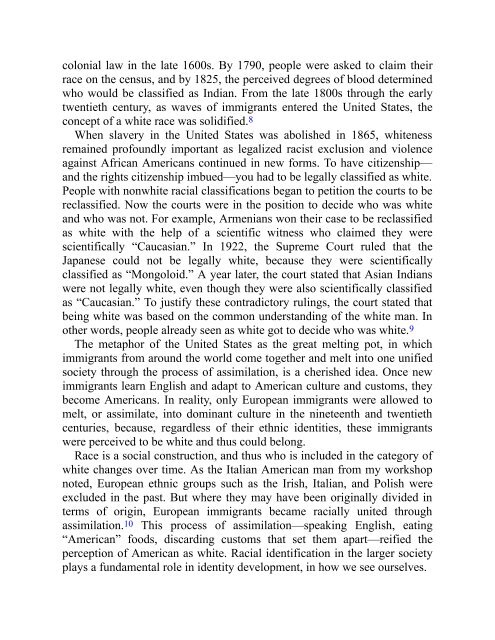You also want an ePaper? Increase the reach of your titles
YUMPU automatically turns print PDFs into web optimized ePapers that Google loves.
colonial law in the late 1600s. By 1790, people were asked <strong>to</strong> claim their<br />
race on the census, and by 1825, the perceived degrees of blood determined<br />
who would be classified as Indian. From the late 1800s through the early<br />
twentieth century, as waves of immigrants entered the United States, the<br />
concept of a white race was solidified. 8<br />
When slavery in the United States was abolished in 1865, whiteness<br />
remained profoundly important as legalized racist exclusion and violence<br />
against African Americans continued in new <strong>for</strong>ms. To have citizenship—<br />
and the rights citizenship imbued—you had <strong>to</strong> be legally classified as white.<br />
<strong>People</strong> with nonwhite racial classifications began <strong>to</strong> petition the courts <strong>to</strong> be<br />
reclassified. Now the courts were in the position <strong>to</strong> decide who was white<br />
and who was not. For example, Armenians won their case <strong>to</strong> be reclassified<br />
as white with the help of a scientific witness who claimed they were<br />
scientifically “Caucasian.” In 1922, the Supreme Court ruled that the<br />
Japanese could not be legally white, because they were scientifically<br />
classified as “Mongoloid.” A year later, the court stated that Asian Indians<br />
were not legally white, even though they were also scientifically classified<br />
as “Caucasian.” To justify these contradic<strong>to</strong>ry rulings, the court stated that<br />
being white was based on the common understanding of the white man. In<br />
other words, people already seen as white got <strong>to</strong> decide who was white. 9<br />
The metaphor of the United States as the great melting pot, in which<br />
immigrants from around the world come <strong>to</strong>gether and melt in<strong>to</strong> one unified<br />
society through the process of assimilation, is a cherished idea. Once new<br />
immigrants learn English and adapt <strong>to</strong> American culture and cus<strong>to</strong>ms, they<br />
become Americans. In reality, only European immigrants were allowed <strong>to</strong><br />
melt, or assimilate, in<strong>to</strong> dominant culture in the nineteenth and twentieth<br />
centuries, because, regardless of their ethnic identities, these immigrants<br />
were perceived <strong>to</strong> be white and thus could belong.<br />
Race is a social construction, and thus who is included in the category of<br />
white changes over time. As the Italian American man from my workshop<br />
noted, European ethnic groups such as the Irish, Italian, and Polish were<br />
excluded in the past. But where they may have been originally divided in<br />
terms of origin, European immigrants became racially united through<br />
assimilation. 10 This process of assimilation—speaking English, eating<br />
“American” foods, discarding cus<strong>to</strong>ms that set them apart—reified the<br />
perception of American as white. Racial identification in the larger society<br />
plays a fundamental role in identity development, in how we see ourselves.


















